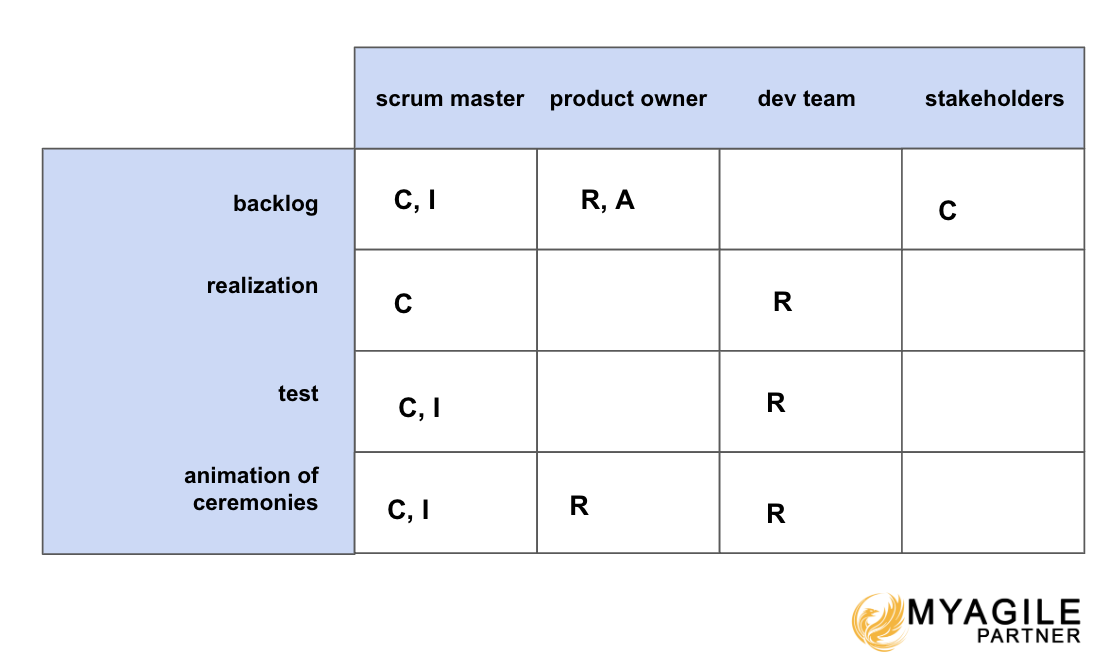
The RACI chart (Responsible, Accountable, Consulted, Informed) is a valuable tool for managing responsibilities within projects and processes. It provides a clear overview of the roles of each individual or group involved, thus clarifying governance.
Here’s the result of a simple RACI chart (for example) below.

However, to make it truly effective, it’s essential to continually improve it.
In this article, we explore tips for optimizing a RACI chart and turning it into a strategic asset in project and process management.
Tips for Your RACI chart
- Clarify Roles and Responsibilities
The first step in improving a RACI chart is to ensure that each role is precisely defined. Avoid ambiguities by clearly specifying what each person or group is responsible for. This clarity fosters trust and understanding within the team.
- Involve Stakeholders
An effective RACI chart requires active involvement of all stakeholders. Collaborate closely with them to identify appropriate roles and ensure that everyone understands their assigned expectations. Stakeholder engagement strengthens commitment and accountability.
- Consider Skills and Expertise
Each individual or group should be assigned tasks that align with their skills and expertise. Verify that individuals assigned to specific roles have the necessary skills for success. If necessary, provide training or additional resources.
- Be Realistic About Workloads
Avoid overburdening a single individual with too many responsibilities. Balanced responsibility distribution helps prevent burnout and maintains a healthy work balance within the team. Ensure that each person can effectively focus on their tasks.
- Regularly Update
A RACI chart is not static. It should evolve with the project or process. Plan regular reviews to ensure it stays aligned with changing needs; this can be done, for example, during retrospectives. New stakeholders or scope adjustments should be taken into account.
- Promote Communication
Use the RACI chart as a communication tool. Ensure that all stakeholders understand how it works and its importance for project or process success. Open communication enhances understanding and engagement.
- Avoid Over-Complexity
An overly complex RACI chart can become counterproductive. Keep it simple and easy to understand. Focus on the essentials to avoid unnecessary confusion.
- Use Project Management Tools
Using project management software, such as Microsoft Project (for traditional project management) or Jira (for agile project management), can simplify the creation and management of RACI matrices by integrating them into your project workflow. These tools facilitate collaboration and real-time updates.
- Formalize Agreements
Ensure that each individual or group understands and accepts their role in the RACI chart. Formalize agreements through meetings, signatures, or documents to reinforce commitment and accountability.
- Be Adaptable
Depending on the evolution of the project or process, be prepared to adjust roles and responsibilities in the RACI chart to reflect reality. Agility is key to efficiency.
Conclusion – RACI chart Tips
A well-constructed RACI chart is a valuable asset for project and process management. Clear governance clarification will prevent many conflicts and time wastage throughout the project lifecycle.
By following these tips, you can enhance it to become a strategic tool that promotes communication, transparency, and your team’s success in managing responsibilities.

Be the first to comment